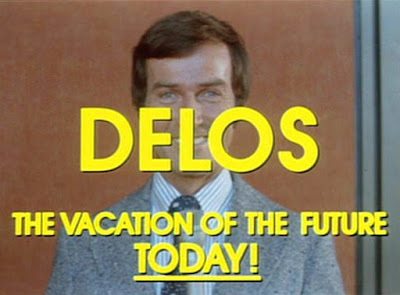Long before being devoured by dinosaurs became the vacation rage, author/director Michael Crichton devised an earlier, alternate-reality getaway..."Westworld".
In the mythical story, Westworld (or Westernworld, as it's sometimes referred in the film) is a Delos Corporation creation, teamed with two similar parks: Medievalworld and Romanworld (the latter, Pompeii influenced). Each park is populated by androids so amazing in detail that they're practically indistinguishable from their human guests. They interact with one as any human would, form relationships with one ...struggle against one, too, if that's what the arranged plot line dictates, and all this for a measly thousand dollars a day.
Sounds fetching, right? Unfortunately, the Delos marketing department didn't foresee that the robots would adapt free will and a taste for revenge.
It should be noted that "Westworld" (released in '73) rode the heels of Robert Wise's '71 film adaptation of Crichton's "Andromeda Strain", which detailed the consequences of an extraterrestrial virus. A virus also acts as the catalyst in "Westworld", though it's a computerized variation: quite a prophetic leap for a film forty-plus years old.
The misadventure commences with two friends, Peter Martin (Richard Benjamin) and John Blane (James Brolin), en route to the cowboy resort. Blane has visited Westworld before and plans to show Martin, who's in the aftermath of a divorce, a good time. Indeed, Westworld's rip-snortin' atmosphere should do the trick, with its bank robberies, chair-crashing brawls, cat-house romps and of course, those ever engaging gun fights.
There's one robotic gunslinger, portrayed by Yul Brynner, who faithfully makes the rounds. The robot, in fact, resembles Brynner's character, Chris, from "The Magnificent Seven" movies, but this mechanical counterpart lacks the latter's amiable charm and is apt to prod one into a fight, which is precisely what happens when Martin and Blane visit the local saloon.
Blane encourages Martin to shoot the soft-spoken aggressor, which he does with ease, thus setting the pace for other such spontaneous encounters once the Gunslinger is reactivated upon repair. What the men don't realize is that the Gunslinger is accumulating memories of his defeats, and though designed not to kill, acquires a desire to do so.
Actually, incidents among the parks insinuate a robotic rebellion. A mechanical snake bites Blane at one point, and a Medieval wench slaps a lusting guest, even though she's programmed to please. As the Delos supervisor acknowledges: these are complex machines and the consequences of their advance circuitry is yet to be fully understood. (What's brewing, in fact, is a cognitive revolution straight out of Phillip K. Dick's "Do Androids Dream of Electric Sheep?", or more so, its film adaptation, "Blade Runner.")
Alas, there's little time for the Delos staff to prevent what ensues. The computerized plague causes the Black Knight to slays his human opponent; dagger-geared Romans slaughter visitors; and at Westworld, the Gunslinger confronts his recent adversaries.
The machine shoots Blane and then pursues Martin across the various parks and through their concealed corridors, becoming a relentless cross between Michael Myers and the Terminator (though years before either's advent), pressing the attack into a jolting conclusion.
Though the action is undeniably intense, what appeals to most fans is "Westworld'"s characters. Benjamin and Brolin are identifiable as the unlucky guests. (One's heart goes out to the mild-mannered Martin, in particular: an "everyman" caught in a situation in which he's been reluctant to engage.) Yul Brynner's Gunslinger is a perfect antagonist for them: cool and steely-eyed; one of the most memorable of all cinema's mad robots.
The film is also graced by other familiar faces: Alan Oppenheimer as the concerned, Delos supervisor; Steven Frank and Jared Martin as technicians; Dick Van Patten as a surrogate sheriff; Michael Mikler as the Black Knight; Majel "Nurse Chapel"Barrett/Roddenberry as a madame; and Linda Scott as one of her girls.
"Westworld", unlike the methodical "Andromeda Strain", plays like an allegorical "Twilight Zone" and is reminiscent of "Star Trek'"s "Shore Leave". In this regard, it also feels like "Logan's Run" or the original "Planet of the Apes", offering an uncanny expanse that shouldn't exist, but due to the deft acting, writing and direction, appears credible. Fred Karlin's score, using traditional cowboy themes, seasoned with a robotic drive, also makes the offbeat ambiance absorbing, even when accompanied by the Gunslinger's weird, digital vantage.
Though unjustly overlooked by today's younger audience, "Westworld" was quite a box-office draw in its time, spawning a espionage sequel, "Futureworld", and a brief television series, "Beyond Westworld". (HBO recently rehashed the concept in a yet unaired pilot for another potential series.)
The original remains the best so far: a classic in the opinion of many. Certainly, just based on its "Jurassic" influence alone, "Westworld" has more than made a lasting mark. For those who know it, the film continues to thrill and for those unfamiliar with it, a trailblazing treat awaits.



















No comments:
Post a Comment